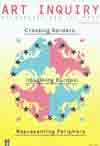The Stone Flower in Pannonia: Collective Trauma, Memory, and War
The Stone Flower in Pannonia: Collective Trauma, Memory, and War
Author(s): Josip ZankiSubject(s): Fine Arts / Performing Arts
Published by: Łódzkie Towarzystwo Naukowe
Keywords: Jasenovac; memory; remembrance; monument; ideology
Summary/Abstract: This paper is an attempt to analyse the relationship between commemorative celebrations and problems of social remembrance, taking as examples the Stone Flower monument of Bogdan Bogdanović and the Memorial Museum permanent exhibition, both situated in Jasenovac Memorial site in Croatia, on the Bosnian border. Jasenovac Concentration Camp was organized in 1941 by the Fascist government of The Independent State of Croatia. It was open until 1945, and in accordance with racist regulations, it operated as a place of killing and torturing Serbs, Roma people, Jews and anti-fascist Croats. The data gathered show numbers of more than 80,000 victims, predominantly Serbs. After liberation and the establishment of The Socialist Federal Republic of Yugoslavia, the question of a memorial centre at the camp location stimulated debate on traumatic historical relations between the two largest nations in Yugoslavia, Serbia and Croatia. Bogdan Bogdanović's monument was erected in 1966 and the Jasenovac Memorial Museum was opened in 1968. Very soon after, the monument became a symbol of reconciliation, not just for the camp victims but for their descendants, as well as for advocates of the former Quisling state. The Memorial Museum exhibition was changed several times, under the pressure and influence of the ruling political ideologies. Today’s exhibition, opened in 2006 created controversy especially for its multimedia representation form. During my research on various forms of remembering and symbolic perception of the place itself I have conducted several interviews with Leonida Kovač, the art historian and author of the Memorial Museum’s permanent exhibition, as well as with members of the Anti- Fascist movement and members of Serbian and Jewish communities. I have also used Lelow’s Jewish community centre in Poland as a reference point in my comparative fieldwork. This community was wiped out during the Holocaust and the post-war Socialist period. Its history and culture can be compared to that of the Serbian community in Croatia. Both communities shared a complex space, impossible to define by national or generalized historical narrative.
Journal: Art Inquiry
- Issue Year: 2013
- Issue No: 15
- Page Range: 107-123
- Page Count: 17
- Language: English

